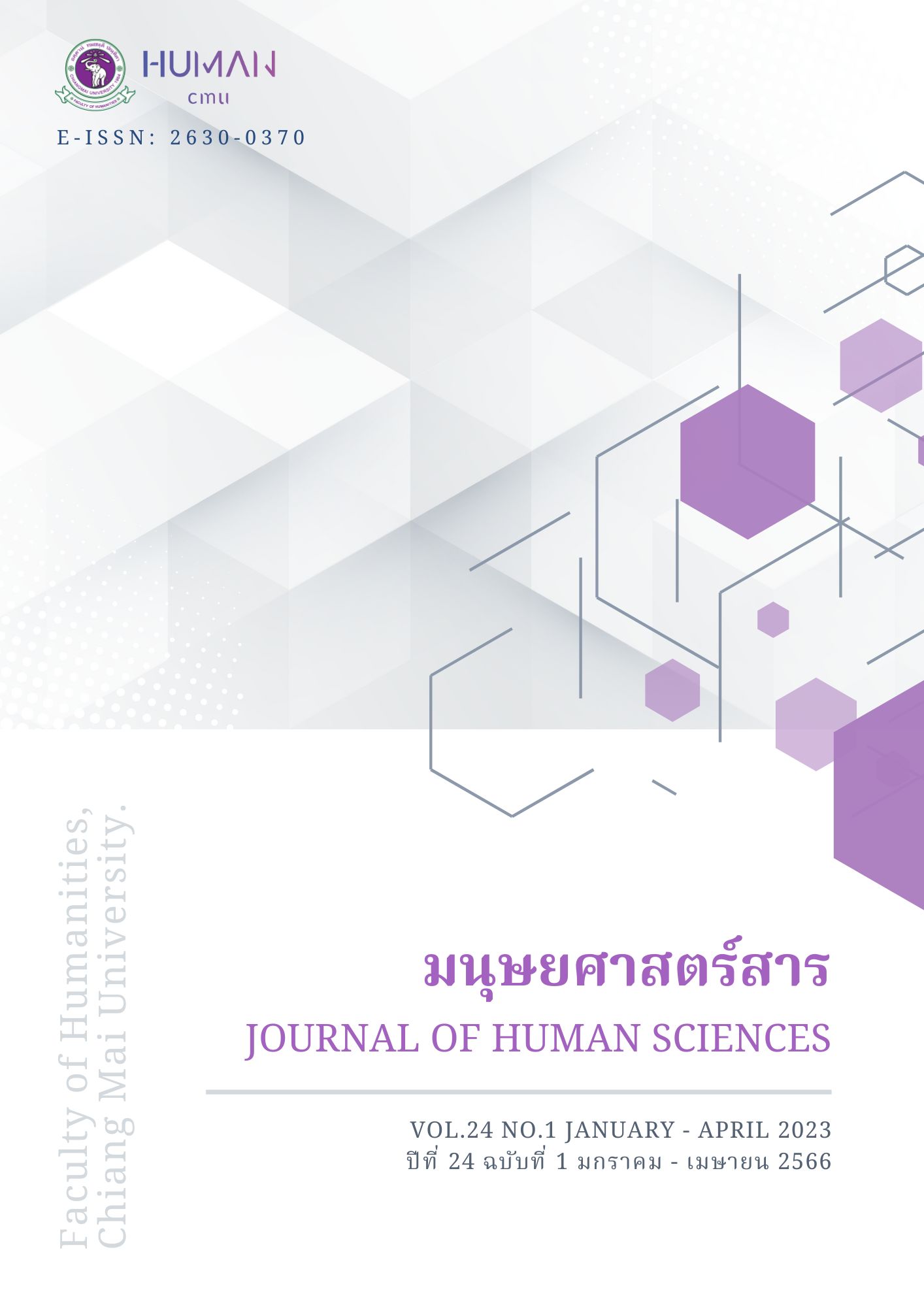การ แปลเครื่องหมายวรรคตอนในตัวบทภาษาเยอรมันเป็นภาษาไทย: กรณีศึกษาการถ่ายทอดหน้าที่เครื่องหมายอัฒภาค ( ; ) ทวิภาค ( : ) และยัติภาค ( - ) ของนักศึกษาวิชาเอกภาษาเยอรมัน คณะมนุษยศาสตร์ มหาวิทยาลัยเชียงใหม่
Main Article Content
บทคัดย่อ
บทความวิจัยนี้วิเคราะห์การแปลเครื่องหมายอัฒภาค ทวิภาค และยัติภาคที่พบในบทความจากหนังสือพิมพ์เยอรมันเป็นภาษาไทยของนักศึกษาวิชาเอกภาษาเยอรมัน คณะมนุษยศาสตร์ มหาวิทยาลัยเชียงใหม่ งานวิจัยนี้มีจุดประสงค์ที่จะแสดงถึงบทบาทหน้าที่ที่สำคัญของเครื่องหมายดังกล่าวในการเชื่อมความระหว่างประโยค และหวังกระตุ้นให้มีการเพิ่มเติมเนื้อหาเกี่ยวกับอักขรวิธีมากขึ้นในการเรียนการสอนภาษาเยอรมันในฐานะภาษาต่างประเทศ จากการวิเคราะห์ข้อมูลที่รวบรวมโดยใช้แบบสอบถามและแบบทดสอบการแปล สามารถสรุปผลการวิจัยได้ดังนี้ ประการแรก เครื่องหมายวรรคตอนดังกล่าวจำเป็นต้องมีรูปแทนในบทแปลภาษาไทย เช่น คำสันธานหรือวลีเชื่อมความอื่นเพื่อให้ประโยคที่แปลออกมาลื่นไหลและมีเนื้อความที่เชื่อมโยงกัน ประการที่สอง ตัวอย่างการแปลที่เลือกใช้รูปแทนที่ผิดหน้าที่หรือความหมายเป็นการตอกย้ำว่า ผู้แปลรู้สึกถึงความจำเป็นที่จะต้องเชื่อมโยงให้ข้อความไหลลื่นโดยใช้กลวิธีใดกลวิธีหนึ่ง ประการที่สาม บทแปลที่เลือกจะไม่ถ่ายทอดหน้าที่ของเครื่องหมายวรรคตอนไม่ได้แสดงว่าผู้แปลปฏิเสธความเชื่อมโยงทางความหมายระหว่างประโยคก่อนและหลังเครื่องหมายวรรคตอน ผู้แปลแสดงความเชื่อมโยงระหว่างข้อความในบทแปลไทยโดยใช้กลวิธีรวบประโยคก่อนและหลังเครื่องหมายวรรคตอนให้เป็นประโยคเดียวหรือหยิบยืมคำสันธานหรือวลีเชื่อมความที่มีอยู่แล้วในประโยคหลังเครื่องหมายวรรคตอน ข้อสรุปทั้งสามประการนี้ชี้ให้เห็นถึงศักยภาพของการศึกษาเกี่ยวกับเครื่องหมายวรรคตอนที่จะช่วยพัฒนาสมรรถนะการอ่านและการเขียนของผู้เรียนภาษาเยอรมันและความสำคัญที่จะนำเครื่องหมายวรรคตอนไปใช้ในการเรียนการสอนภาษาเยอรมันในฐานะภาษาต่างประเทศ
Article Details

อนุญาตภายใต้เงื่อนไข Creative Commons Attribution-NonCommercial-NoDerivatives 4.0 International License.
เอกสารอ้างอิง
ตัวบทที่ใช้ในแบบทดสอบ
Bauchmüller, M. (2020, October 19). Trotz-corona - Chinas Wirtschaft wächst im 3. Quartal stark. Süddeutsche.de. https://www.sueddeutsche.de/wirtschaft/china-coronavirus-wirtschaftswachstum-quartalszahlen-1.5081333
Gorkow, A. (2020, October 8). Literaturnobelpreis – Louise Wer? Süddeutsche.de. https://www.sueddeutsche.de/kultur/louise-glueck-literaturnobelpreis-leben-1.5059458
Janisch, W. (2020, October 21). Was tun mit einem Unbelehrbaren? Süddeutsche.de. https://www.sueddeutsche.de/politik/horst-mahler-holocaust-hitler-1.5082957
Kister, K. (2020, October 12). "Sh*show von Richard Russo. Wurstattacken. Süddeutsche.de. https://www.sueddeutsche.de/kultur/sh-show-richard-russo-buchrezension-buchkritik-literatur-1.5063052
Linnartz, M. (2020, October 20). Schulen sind längst in Der „neuen Normalität“ angekommen. Süddeutsche.de. https://www.sueddeutsche.de/bildung/schulschliessung-meidinger-corona-1.5084635
Seibt, G. (2020, October 8). Nachruf auf Gunter de Bruyn: Der schwarze Horizont. Süddeutsche.de. https://www.sueddeutsche.de/kultur/guenter-de-bruyn-gestorben-nachruf-1.5059407
Vahabzadeh, S. (2020, October 21). Neuer Roman von Don Delillo: Auf sich zurückgeworfen. Süddeutsche.de. https://www.sueddeutsche.de/kultur/don-de-lillo-die-stille-kritik-1.5084601
Zeitung, S. (2020, October 21). EU-staaten einigen sich auf Agrarreform. Süddeutsche.de. https://www.sueddeutsche.de/politik/eu-agrarreform-landwirtschaft-umweltschuetzer-1.5086424
เอกสารทุติยภูมิภาษาเยอรมัน
Attaviriyanupap, K. (2017). „Kopula oder keine Kopula? Das ist hier die Frage. Deutsche Kopulakonstruktionen mit sein aus der Perspektive des Thailändischen“ In P. Akkaramas/ H. Funk/ S. Traoré (eds.) Deutsch als Fremdsprache im Spannungsfeld zwischen Globalisierung und Regionalisierung (pp. 351-369). Frankfurt a. M.: Peter Lang.
Eisenberg, P. (1995): Die deutsche Orthographie und Deutsch als Fremdsprache: analoge Strukturierung von System und Erwerb? In Jahrbuch Deutsch als Fremdsprache 21, 171–184.
Gallmann, P. (1996): Interpunktion (Syngrapheme). In: H. Günther/ O. Ludwig (eds.) Schrift und Schriftlichkeit. Ein interdisziplinäres Handbuch internationaler Forschung (pp. 1456-1467). Berlin: De Gruyter.
Duden. (2014). Handbuch Zeichensetzung: Der praktische Ratgeber Zu Komma, Punkt und Allen anderen Satzzeichen. Berlin: Duden.
Ström Herold, J. & Levin, M. (2022). The Colon in English, German and Swedish: A Contrastive Corpus-Based Study. In P. Rössler, P. Besl & A. Saller (eds.) Vergleichende Interpunktion – Comparative Punctuation (pp. 237-262). Berlin: De Gruyter. https://doi.org/10.1515/9783110756319-011
Thurmair, M. (2022). Interpunktion – (K)ein Thema für Deutsch als Fremdsprache?. In P. Rössler, P. Besl & A. Saller (eds.) Vergleichende Interpunktion – Comparative Punctuation (pp. 317-342). Berlin: De Gruyter. https://doi.org/10.1515/9783110756319-014
Duden. (2016). Duden Die Grammatik. Band 4. Berlin: Duden.
เอกสารทุติยภูมิภาษาไทย
วรรณา แสงอร่ามเรือง. (2545). ทฤษฎีและหลักการแปล (พิมพ์ครั้งที่ 2). กรุงเทพ: สำนักพิมพ์แห่งจุฬาลงกรณ์มหาวิทยาลัย.


